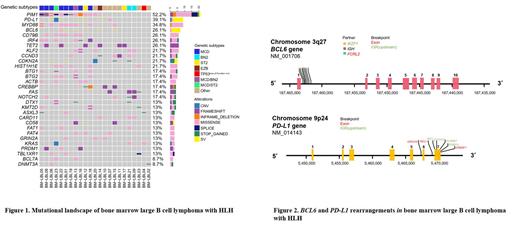Introduction: Bone marrow large B cell lymphoma associated with hemophagocytic lymphohistiocytosis (HLH) is a rare disease with a highly aggressive clinical course. Until now, the molecular genomics of bone marrow large B cell lymphoma associated with HLH remains undetermined.
Methods: Cases of bone marrow large B cell lymphoma with HLH were included. The inclusion criteria were as follows: (1) diagnosis of large B cell lymphoma presenting initially in the bone marrow; (2) no overt lymph node involvement or tumor formation; (3) fulfillment of five or more of the eight HLH-2004 diagnostic criteria. (4) cases with available samples. Genomic DNA was extracted from bone marrow cells or the plasma. A panel comprising 475 hematological malignancy-related genes were used for targeted gene sequencing. The prepared library was sequenced using Illumina HiSeq 4000. Molecular classification was predicted by using the LymphGen algorithm.
Results: A total of 23 cases were included. The median age was 63. 71.4% of patients were the non-GCB subtype (10/14) based on the Hans algorithm and 50% (9/18) of cases showed CD5 expression. Somatic mutations were identified in all the cases. The most common disrupted genes were PIM1 (12/23, 52.2%), PD-L1 (9/23, 39.1%), MYD88 (8/23, 34.8%), BCL6 (6/23, 26.1%), CD79B (6/23, 26.1%), IRF4 (6/23, 26.1%) and TET2 (6/23, 26.1%) (Figure 1). For nine cases with PD-L1 aberrations, seven cases had PD-L1 structural variants (SVs) and one case showed PD-L1 amplification (Figure 2). All the six cases with BCL6 aberrations showed BCL6 SVs (Figure 2). For six cases with BCL6 SVs, four cases showed immunoglobulin heavy chain ( IGH)- BCL6 translocations and two cases harbored IKZF1- BCL6 translocations. Regarding molecular classification, eight cases (34.8%) were classified as the MCD subtype, two cases the BN2 subtype, two cases the ST2 subtype, and two cases the composite subtype.
Conclusion: To the best of our knowledge, this is the first study exploring the molecular genetics of bone marrow large B cell lymphoma with HLH. Our study suggesting bone marrow large B cell lymphoma with HLH showed frequent MYD88/CD79B and PD-L1 alterations. Our study provided clues for the pathogenesis of bone marrow large B cell lymphoma with HLH and identified potential druggable targets for future clinical trials.
Disclosures
No relevant conflicts of interest to declare.


This feature is available to Subscribers Only
Sign In or Create an Account Close Modal